A Small-Town Economic Revitalisation Conundrum: Focus on Tourism, Manufacturing, or Both?
Abstract
1. Introduction
2. Methods
2.1. Introduction
2.2. Analytic Strategy
2.3. Basic Datasets
2.4. Non-Linear and Linear Regression Analyses
3. Results
3.1. Population-Based Orderliness
3.2. Enterprise-Based Orderliness
3.3. Manufacturing Enterprise-Based Impacts
3.4. Tourism Enterprise-Based Impacts
3.5. Combined Enterprise Dynamics of Manufacturing and Tourism Sectors
4. Discussion
Funding
Institutional Review Board Statement
Informed Consent Statement
Data Availability Statement
Acknowledgments
Conflicts of Interest
References
- Marré, A. Rural population loss and strategies for recovery. Econ. Focus First Quart. 2020, 1Q, 27–30. [Google Scholar]
- Johnson, K.M.; Voss, P.R.; Hammer, R.B.; Fuguitt, G.V.; McNiven, S. Temporal and spatial variation in age-specific net migration in the United States. Demography 2005, 42, 791–812. [Google Scholar] [CrossRef] [PubMed]
- Johnson, K.M. Rural Demographic Change in the New Century: Slower Growth, Increased Diversity; No. 44; Carsey Institute Issue Brief: Durham, NH, USA, 2012. [Google Scholar]
- Tacoli, C.; Agergaard, J. Urbanisation, Rural Transformations and Food Systems: The Role of Small Towns; IIED Working Paper; IIED: London, UK, 2017. [Google Scholar]
- Hart, J.F. Small towns and manufacturing. Geogr. Rev. 1988, 78, 272–287. [Google Scholar] [CrossRef]
- Desilver, D. Most Americans Unaware That as U.S. Manufacturing Jobs Have Disappeared, Output Has Grown; Facttank; Pew Research Center: Washington, DC, USA, 2017; Available online: https://www.pewresearch.org/fact-tank/2017/07/25/most-americans-unaware-that-as-u-s-manufacturing-jobs-have-disappeared-output-has-grown/ (accessed on 22 May 2021).
- Devol, R.; Wisecarver, S. Micropolitan Success Stories from the Heartland; The Walton Foundation: Bentonville, AR, USA, 2018. [Google Scholar]
- Devol, R.; Crews, J.; Wisecarver, S. Most Dynamic Micropolitans; Walton Foundation: Bentonville, AR, USA, 2019. [Google Scholar]
- Hasanov, F. Dutch Disease and the Azerbaijan economy. Communist Post Communist Stud. 2013, 46, 463–480. [Google Scholar]
- Hlatshwayo, S.; Spence, M. Demand and defective growth patterns: The role of the tradable and non-tradable sectors in an open economy. Am. Econ. Rev. 2014, 104, 272–277. [Google Scholar] [CrossRef]
- Moretti, E. The New Geography of Jobs; Mariner Books: Boston, MA, USA, 2013. [Google Scholar]
- Moretti, E.; Thulin, P. Local multipliers and human capital in the United States and Sweden. Ind. Corp. Chang. 2013, 22, 339–362. [Google Scholar] [CrossRef]
- UNWTO. International Tourism Highlights; United Nations World Tourism Organization: Madrid, Spain, 2019. [Google Scholar]
- Zeng, D.-Z.; Zhuy, X. Tourism and industrial agglomeration. Jpn. Econ. Rev. 2010, 62, 537–561. [Google Scholar] [CrossRef]
- Hazari, B.R.; Sgro, P.M. Tourism, Trade and National Welfare; Elsevier: Amsterdam, The Netherlands, 2004. [Google Scholar]
- Forsyth, P.; Dwyer, L.; Spurr, R. Is Australian tourism suffering Dutch Disease? Ann. Tour. Res. 2014, 46, 1–15. [Google Scholar] [CrossRef]
- Bolwell, D.; Weinz, W. Reducing Poverty through Tourism; International Labour Office, ILO Sectoral Activities Programme: Geneva, Switzerland, 2008. [Google Scholar]
- Copeland, B.R. Tourism, welfare and de-industrialization in a small open economy. Economica 1991, 58, 515–529. [Google Scholar] [CrossRef]
- Larsen, E.R. Escaping the Resource Curse and the Dutch Disease? When and why Norway caught up with and forged ahead of its neighbors. Am. J. Econ. Soc. 2006, 65, 605–640. [Google Scholar] [CrossRef]
- Nowak, J.; Sahli, M. Coastal tourism and ‘Dutch disease’ in a small island economy. Tour. Econ. 2007, 13, 49–65. [Google Scholar] [CrossRef]
- Van der Ploeg, F. Natural resources: Curse or blessing? J. Econ. Lit. 2011, 49, 366–420. [Google Scholar] [CrossRef]
- Corden, W.; Neary, J. Booming sector and de-industrialisation in a small open economy. Econ. J. 1982, 92, 825–848. [Google Scholar] [CrossRef]
- Mathew, P.M. India’s ‘Dutch Disease’: Can SMEs provide the medicine? Econ. Polit. Wkly. 2014, 49, 191–192. [Google Scholar]
- Beine, M.; Coulombe, S.; Vermeulen, W.N. Dutch Disease and the mitigation effect of migration: Evidence from Canadian provinces. Econ. J. 2015, 125, 1574–1615. [Google Scholar] [CrossRef][Green Version]
- MacEwan, A. Puerto Rico: Suffering the “Dutch Disease” in reverse. Soc. Econ. Stud. 2017, 66, 185–210. [Google Scholar]
- Chao, C.; Hazari, B.R.; Laffargue, J.; Sgro, P.M.; Yu, E.S.H. Tourism, Dutch Disease and welfare in an open dynamic economy. Jpn. Econ. Rev. 2006, 57, 501–515. [Google Scholar] [CrossRef]
- Ojaghlou, M. Tourism-led growth and risk of the Dutch Disease: Dutch Disease in Turkey. Int. J. Bus. Res. 2019, 12, 103–120. [Google Scholar] [CrossRef]
- Holzner, M. Tourism and economic development: The Beach Disease? Tour. Manag. 2011, 32, 922–933. [Google Scholar] [CrossRef]
- U.S. Census Bureau. Micropolitan America; 2019. Available online: https://www.census.gov/library/visualizations/2019/demo/micropolitan-america.html (accessed on 15 January 2021).
- Partridge, M.D.; Rickman, D.S. The Geography of American Poverty: Is There a Need for Place-Based Policies? W.E. Upjohn Institute for Employment Research: Kalamazoo, MI, USA, 2006; Available online: https://research.upjohn.org/cgi/viewcontent.cgi?article=1012&context=up_press (accessed on 22 May 2021).
- Toerien, D.F. Disproportionate agglomeration and scaling in regional socioeconomic analyses: Alabama counties as a case study. Cogent. Soc. Sci. 2020, 6, 1817256. [Google Scholar] [CrossRef]
- Toerien, D.F. Power laws and the demographic-socioeconomic-entrepreneurial nexus of United States counties. In Advances in Sociology Research; Jaworski, J.A., Ed.; Nova Science Publishers: New York, NY, USA, 2020; Volume 32, pp. 65–115. [Google Scholar]
- Toerien, D.F. Entrepreneurial space and enterprise richness in a group of U.S. counties before, during, and after economic turmoil. J. Rural Comm. Dev. 2021, 16, 175–194. [Google Scholar]
- Bettencourt, L.M.A. The origins of scaling in cities. Science 2013, 340, 1438–1441. [Google Scholar] [CrossRef] [PubMed]
- Youn, H.; Bettencourt, L.M.A.; Lobo, J.; Strumsky, D.; Samaniego, H.; West, G.B. Scaling and universality in urban economic diversification. J. R. Soc. Interface 2016, 13, 20150937. [Google Scholar] [CrossRef] [PubMed]
- Lobo, J.; Bettencourt, L.M.; Smith, M.; Ortman, S. Settlement scaling theory: Bridging the study of ancient and contemporary urban systems. Urban Stud. 2020, 57, 731–747. [Google Scholar] [CrossRef]
- Bettencourt, L.M.A.; Lobo, J.; Youn, H. The hypothesis of urban scaling: Formalization, implications and challenges. arXiv 2013, arXiv:1301.5919. [Google Scholar]
- Ortman, S.G.; Davis, K.E.; Lobo, J.; Smith, M.E.; Bettencourt, L.M.A.; Trumbo, A. Settlement scaling and economic change in the Central Andes. J. Archaeol. Sci. 2016, 73, 94e106. [Google Scholar] [CrossRef]
- Ribeiro, F.L.; Lobo, J.; Rybski, D. Zipf’s law and urban scaling: Hypotheses towards a Unified Urban Theory. arXiv 2021, arXiv:2107.11782v1. [Google Scholar]
- Schläpfer, M.; Bettencourt, L.M.A.; Grauwin, S.; Raschke, M.; Claxton, R.; Smoreda, Z.; West, G.B.; Ratti, C. The scaling of human interactions with city size. J. R. Soc. Interface 2014, 11, 20130789. [Google Scholar] [CrossRef]
- Bettencourt, L.M.A. Impact of changing technology on the evolution of complex informational networks. Proc. IEEE 2014, 102, 1878–1891. [Google Scholar] [CrossRef]
- Bettencourt, L.M.A.; Lobo, J.; Helbing, D.; Kühnert, C.; West, G.B. Growth, innovation, scaling, and the pace of life in cities. Proc. Natl. Acad. Sci. USA 2007, 104, 7301–7306. [Google Scholar] [CrossRef]
- Toerien, D. Orderliness in tourism enterprise dynamics in United States micropolitan statistical areas. Sustainability 2021, 13, 6180. [Google Scholar] [CrossRef]
- Walker, B. Resilience: What it is and is not. Ecol. Soc. 2020, 25, 11. [Google Scholar] [CrossRef]
- Toerien, D.F.; Seaman, M.T. The enterprise ecology of towns in the Karoo, South Africa. S. Afr. J. Sci. 2010, 106, 1–10. [Google Scholar] [CrossRef][Green Version]
- Toerien, D.F.; Seaman, M.T. Proportionality in enterprise development of South African towns. S. Afr. J. Sci. 2012, 108, 1–10. [Google Scholar] [CrossRef]
- Toerien, D.F. Productive knowledge, scaling, enterprise richness and poverty in a group of small U.S. counties. Cogent Soc. Sci. 2018, 4, 1560883. [Google Scholar] [CrossRef]
- U.S. Census Bureau. 2016 SUSB Annual Data Tables by Establishment Industry; 2018. Available online: https://www.census.gov/data/tables/2016/econ/susb/2016-susb-annual.html (accessed on 25 May 2021).
- United States. North American Industry Classification System; Executive Office of the President: Washington, DC, USA, 2017. [Google Scholar]
- U.S. Census Bureau. Annual Estimates of the Resident Population for Micropolitan Statistical Areas in the United States and Puerto Rico: 1 April 2010 to 1 July 2019. 2021. Available online: https://www.census.gov/data/tables/time-series/demo/popest/2010s-total-metro-and-micro-statistical-areas.html (accessed on 18 June 2021).
- West, G. Scale: The Universal Laws of Life and Death in Organisms, Cities and Companies; Weidenfeld & Nicolson: London, UK, 2017. [Google Scholar]
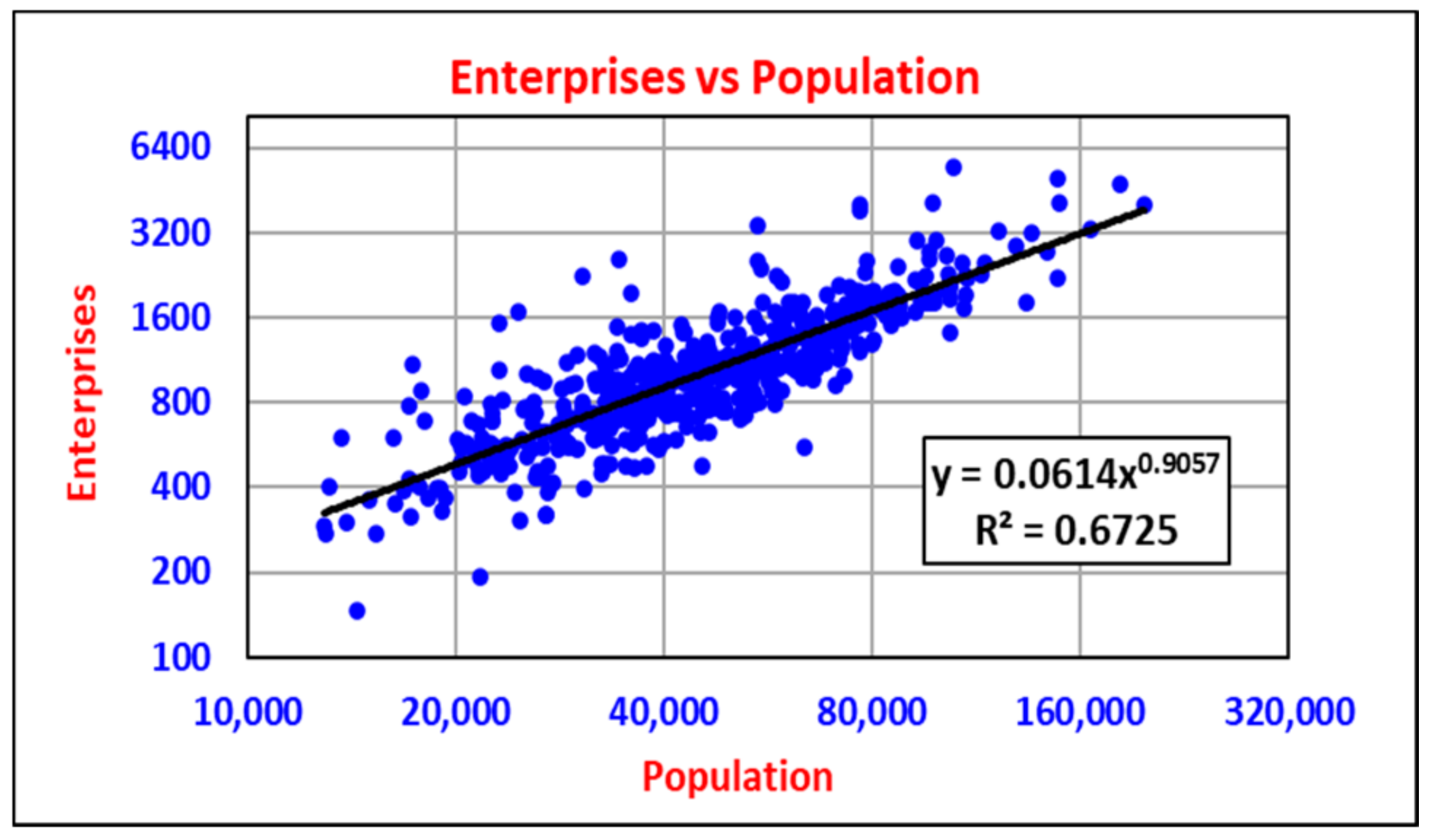


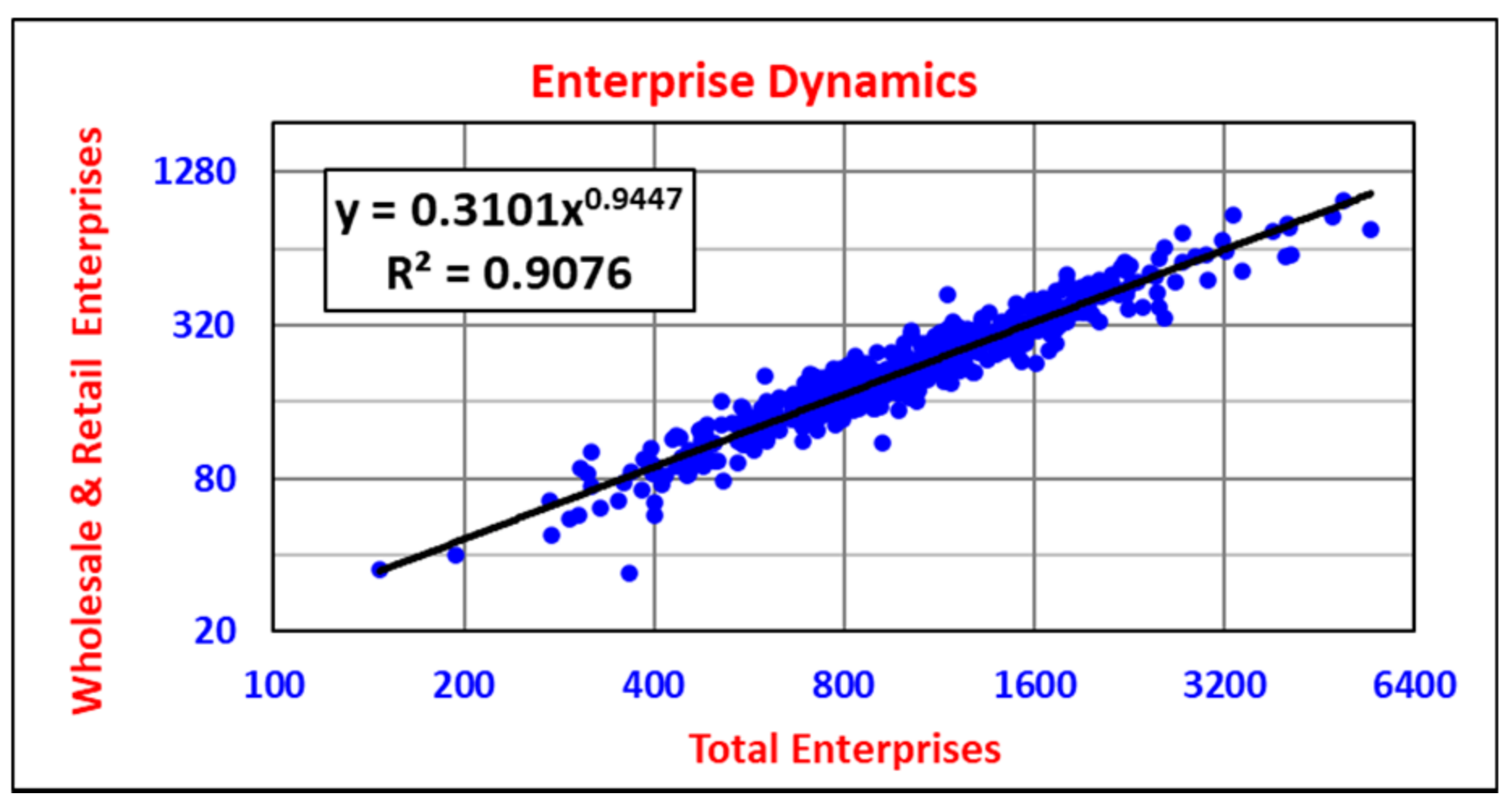

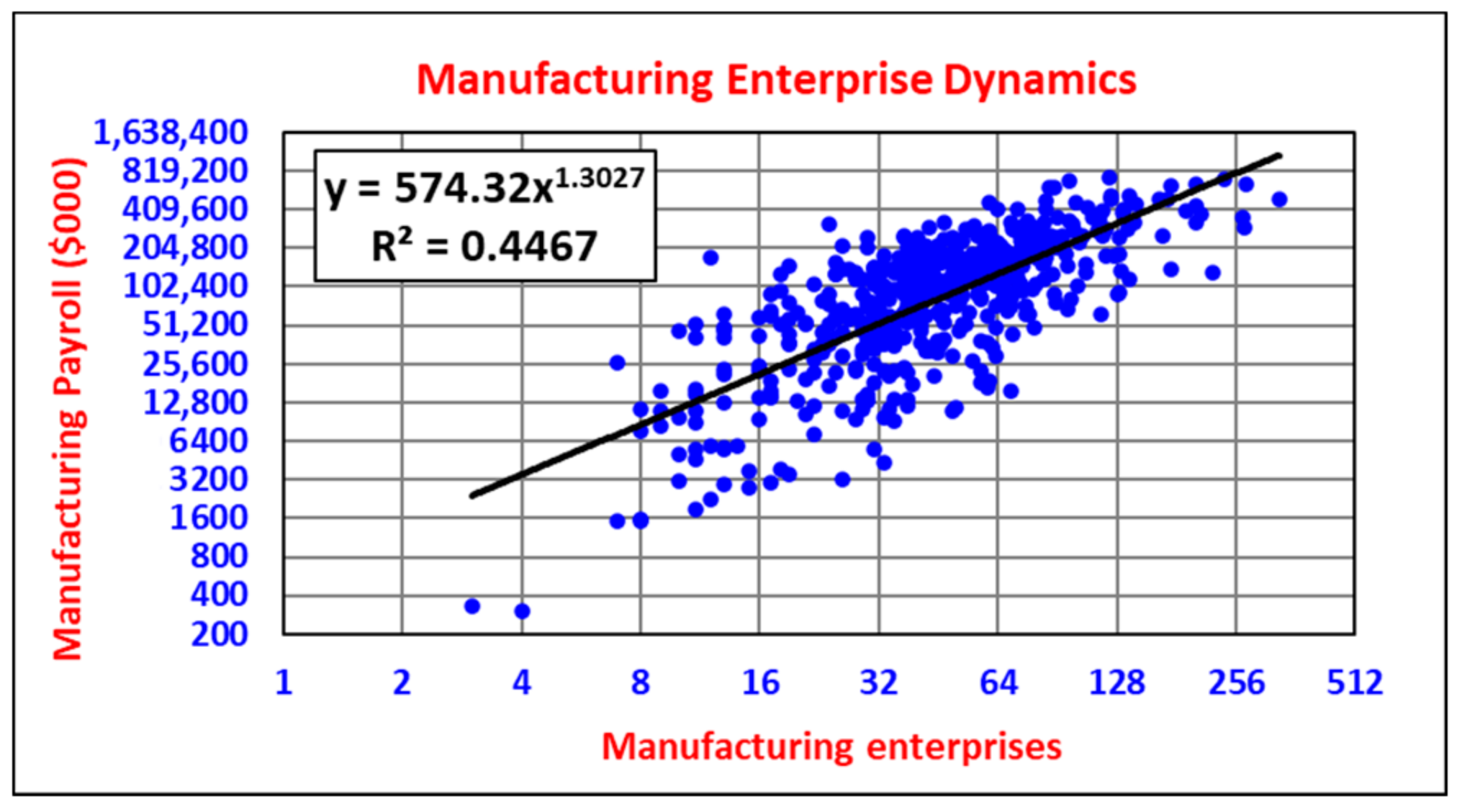
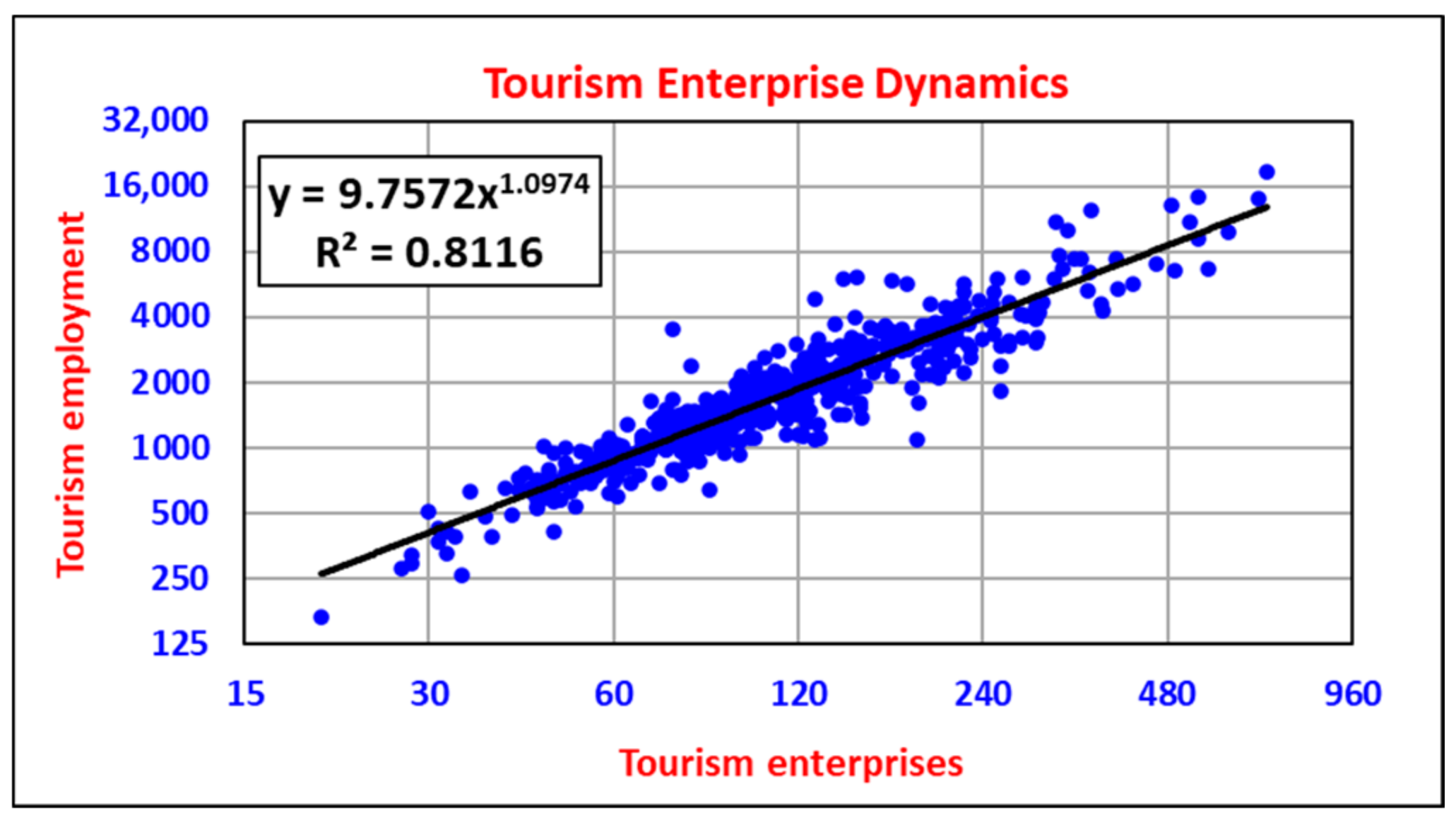
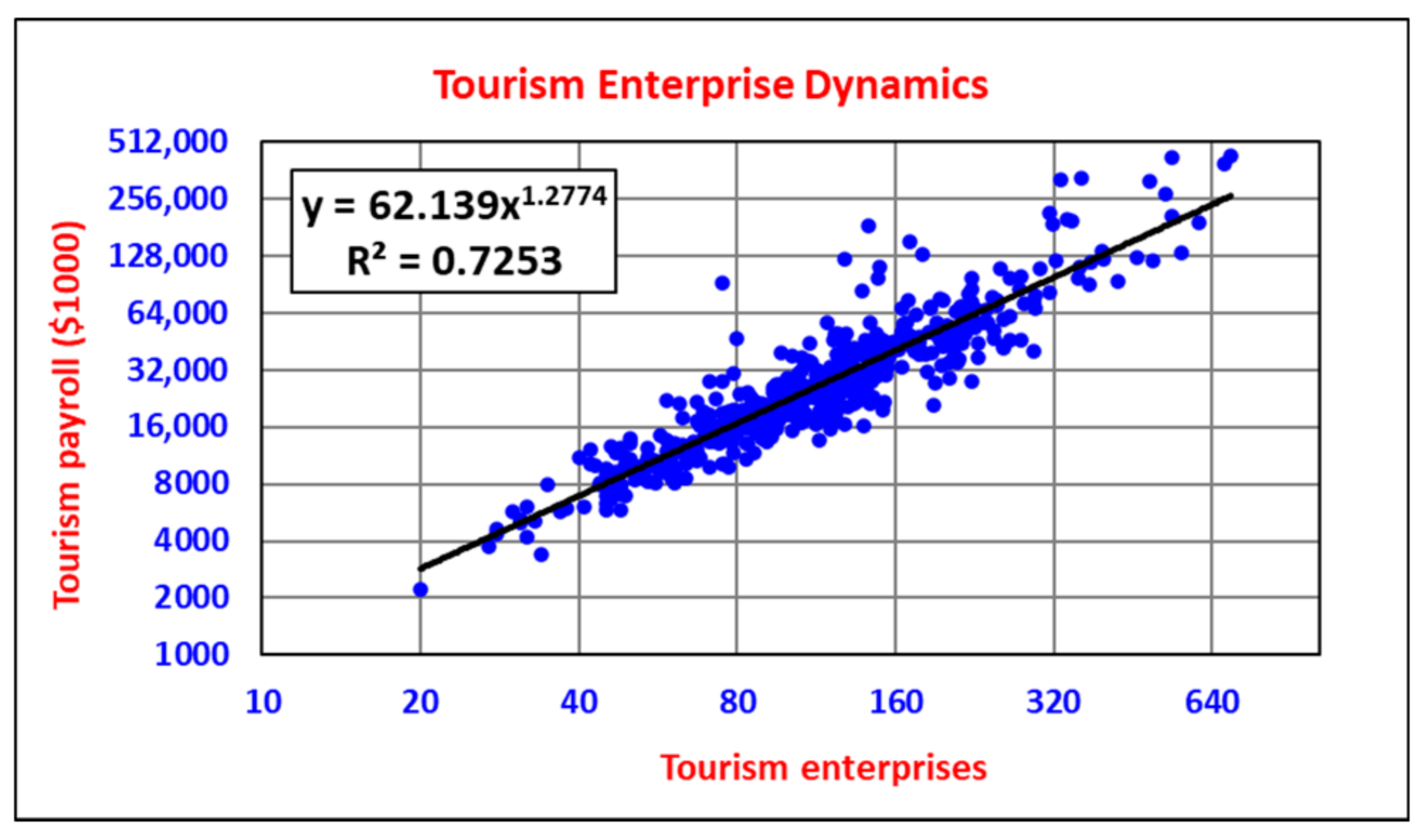


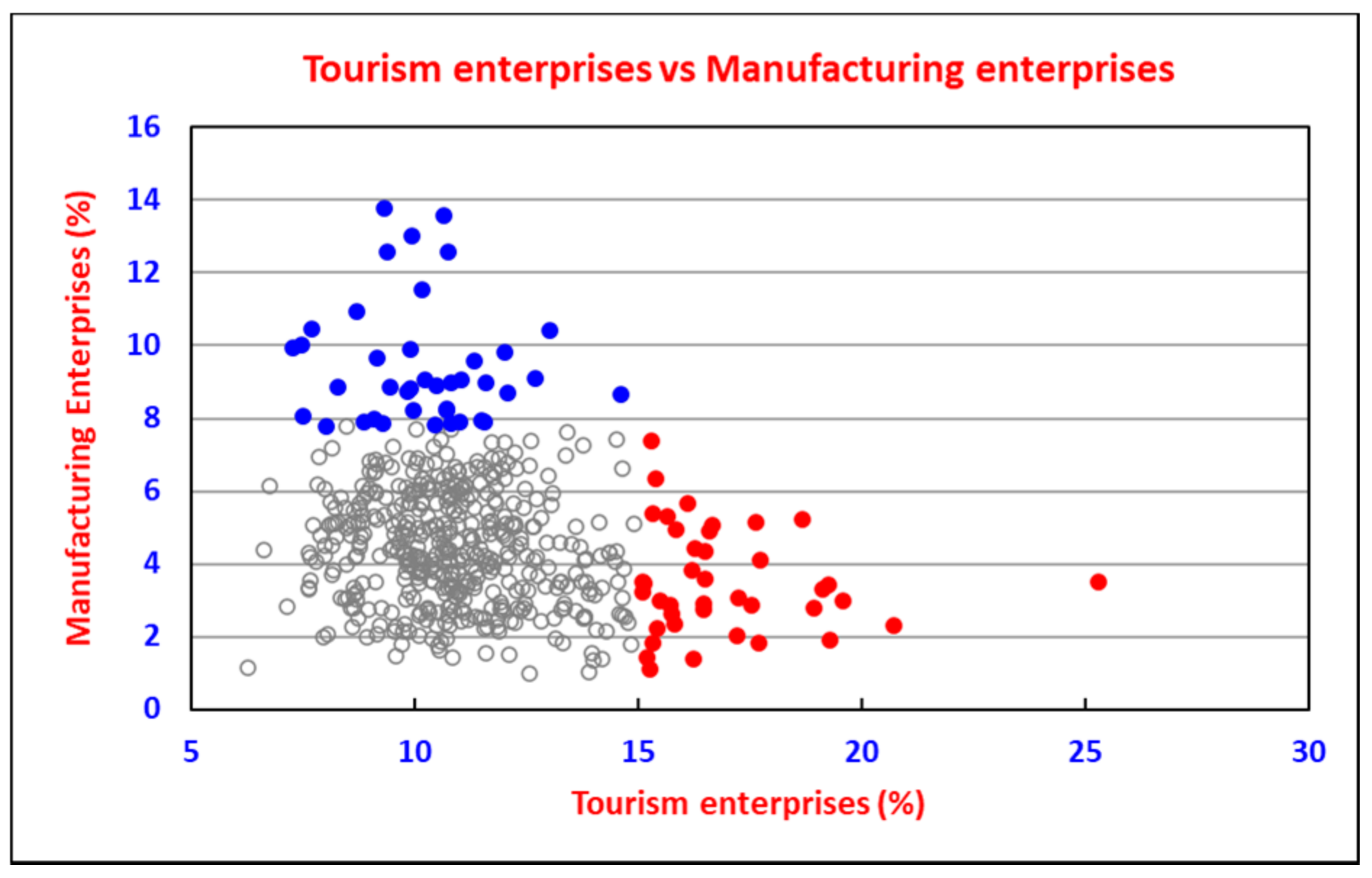
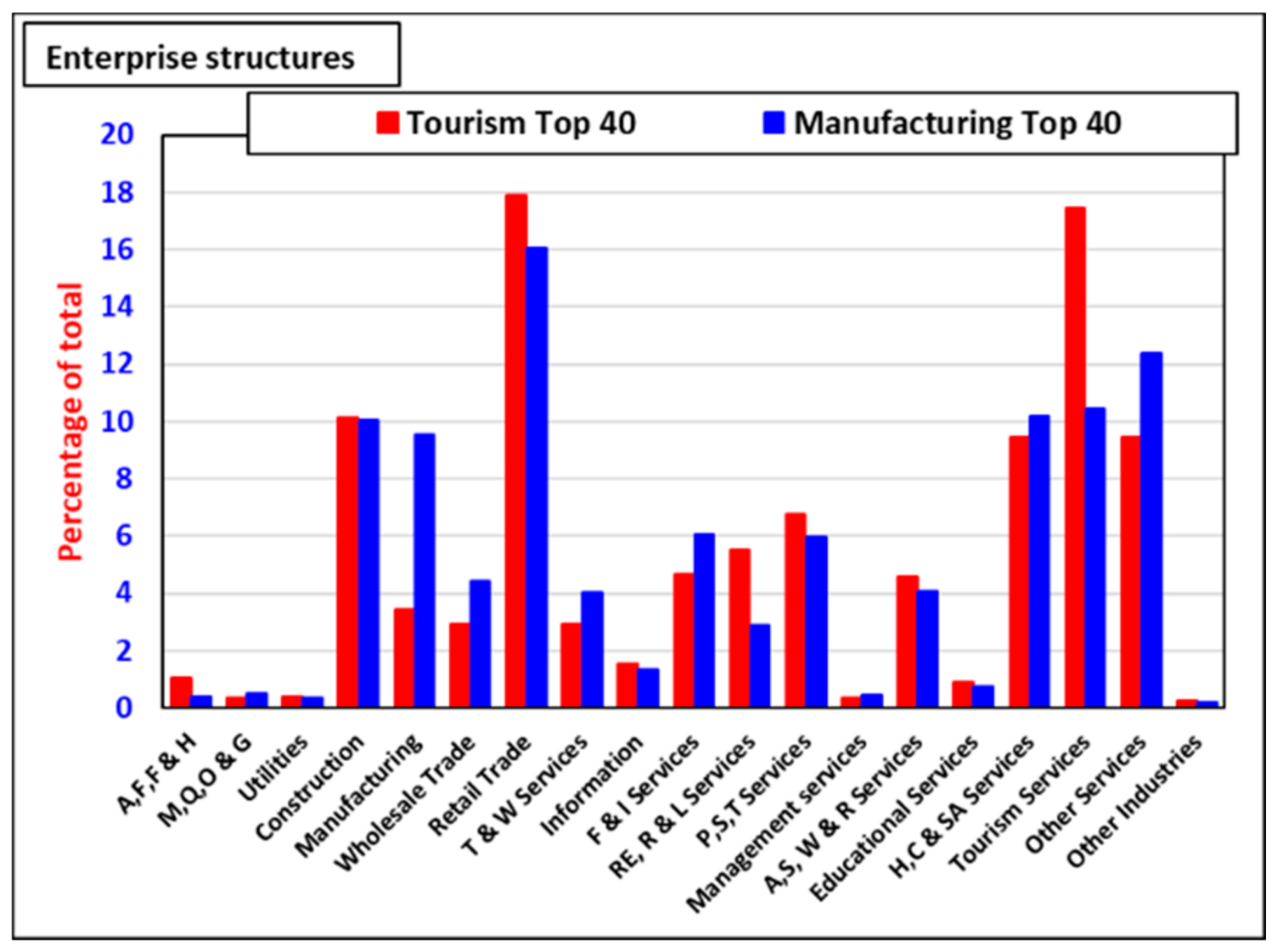
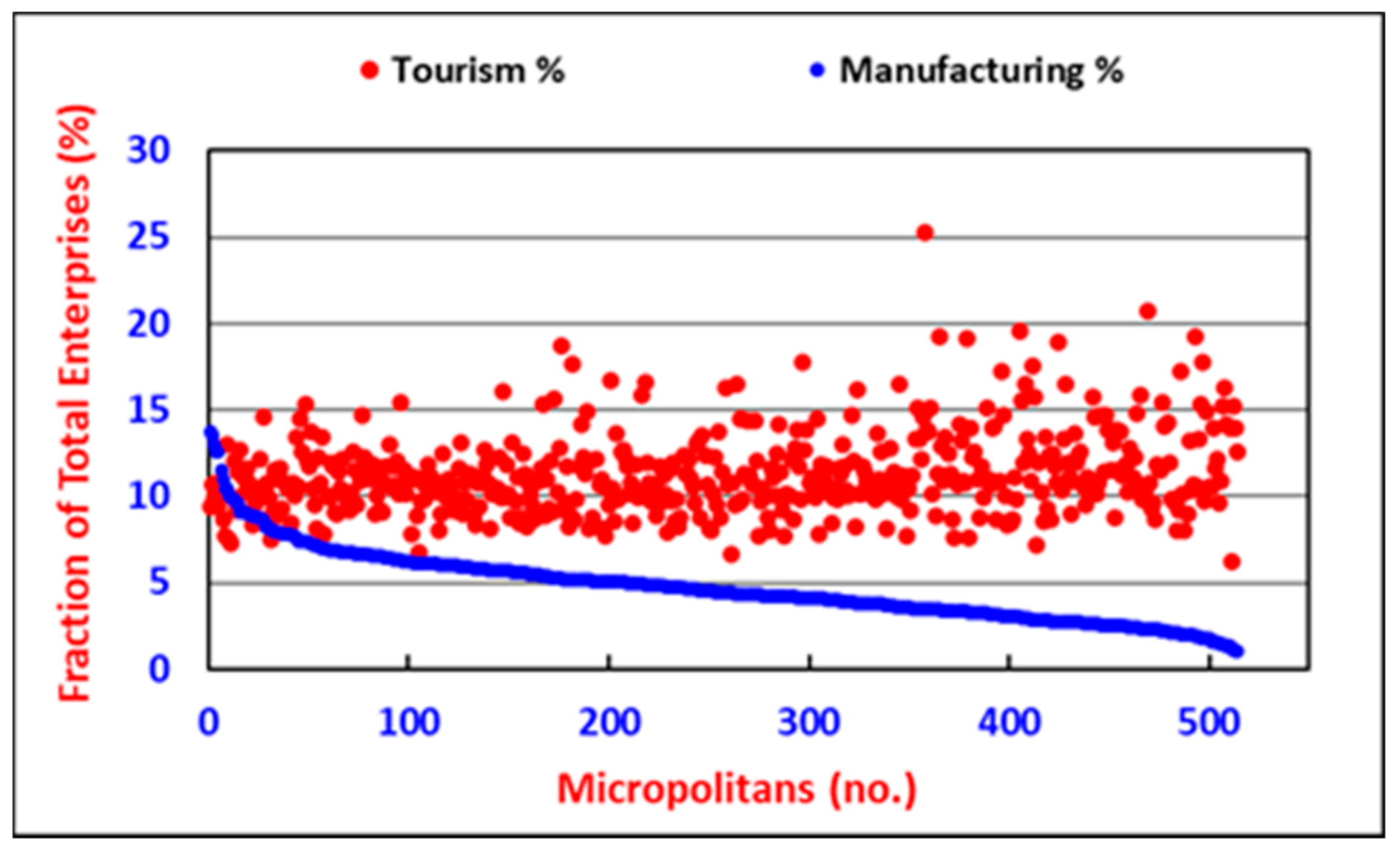
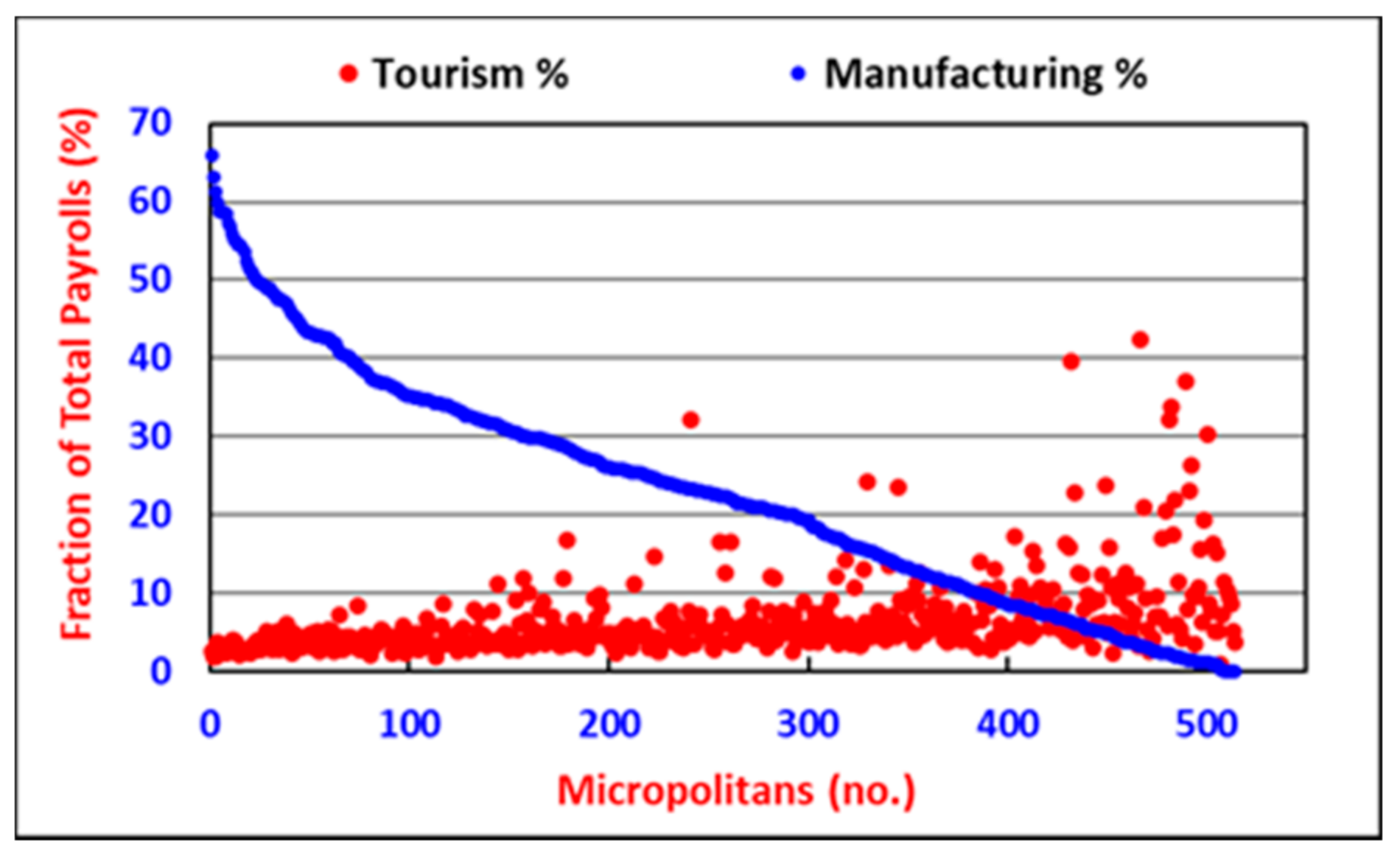
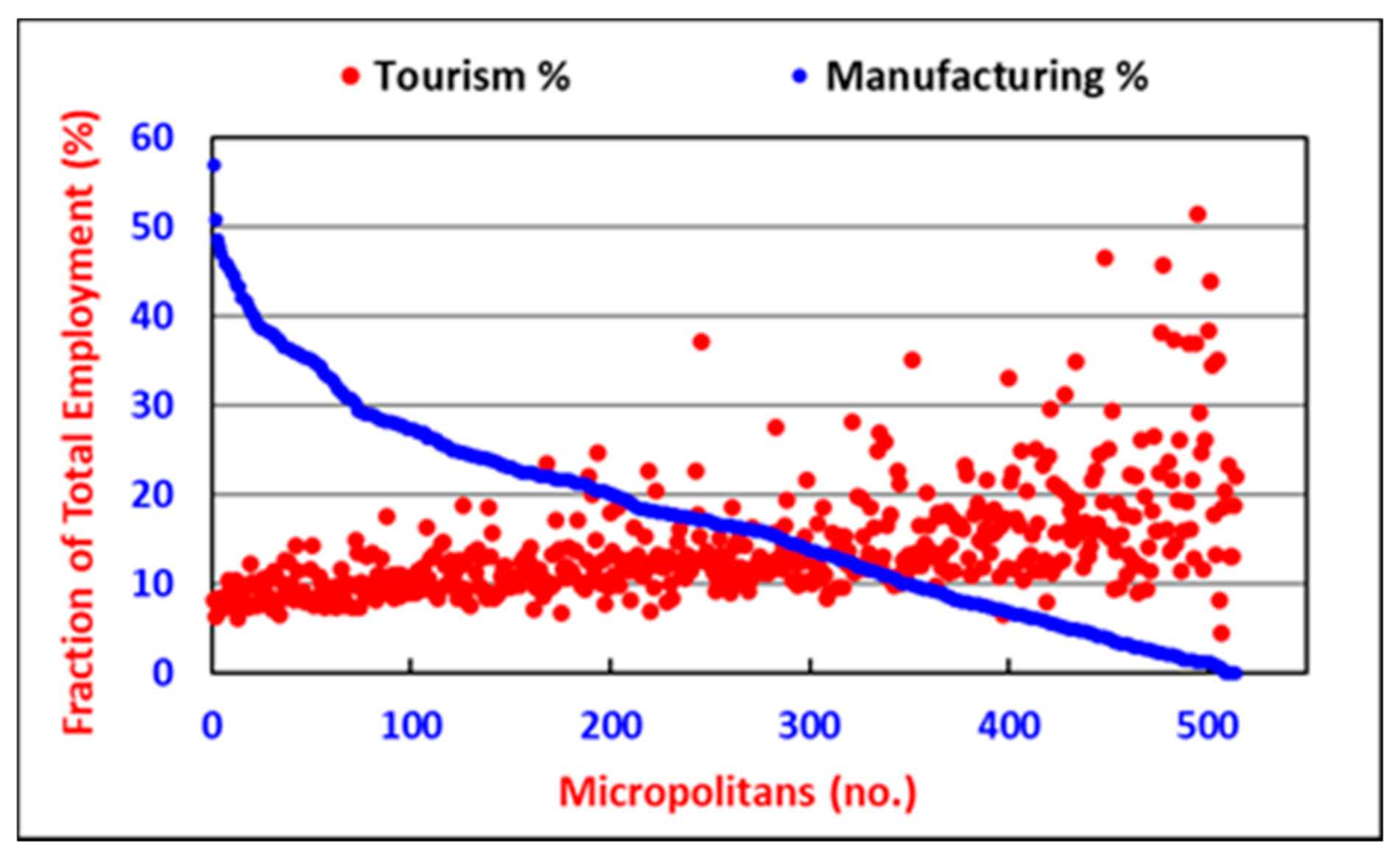
| Number | Six-Digit NAICS Classifications Starting with | Economic Sectors |
|---|---|---|
| 1 | 11 | Agriculture, forestry, fishing and hunting |
| 2 | 21 | Mining, quarrying, and oil and gas extraction |
| 3 | 22 | Utilities |
| 4 | 23 | Construction |
| 5 | 31,32,33 | Manufacturing |
| 6 | 42,44,45 | Wholesale trade and retail trade |
| 7 | 48,49 | Transport and warehousing |
| 8 | 51 | Information |
| 9 | 52 | Finance and insurance |
| 10 | 53 | Real estate and rental and leasing. |
| 11 | 54,55 | Professional, scientific, technical services and management of companies and enterprises |
| 12 | 56 | Administrative and support and waste management and remediation services |
| 13 | 61 | Educational services |
| 14 | 62 | Health care and social assistance |
| 15 | 71 | Arts, entertainment, and recreation |
| 16 | 72 | Accommodation and food services |
| 17 | 81 | Other services |
| Characteristic No. 1 | Characteristic No. 2 | R2 | Exponent | Constant |
|---|---|---|---|---|
| Population | GDP | 0.6698 | 0.8744 | 156.67 |
| Population | Employees | 0.7632 | 1.0062 | 0.2762 |
| Population | Payrolls | 0.6532 | 1.0133 | 9.1494 |
| Population | Tourism enterprises | 0.5242 | 0.9203 | 0.0058 |
| Population | Manufacturing enterprises | 0.5353 | 1.0425 | 0.0006 |
| Independent Characteristic | Dependent Characteristic | R2 | Exponent | Constant |
|---|---|---|---|---|
| Total enterprise numbers | Financial and insurance services | 0.7852 | 0.8258 | 0.2067 |
| Total enterprise numbers | Construction services | 0.8221 | 1.1995 | 0.0228 |
| Total enterprise numbers | Transport and warehousing services | 0.4706 | 0.8485 | 0.1012 |
| Total enterprise numbers | Information services | 0.7872 | 0.9036 | 0.0301 |
| Total enterprise numbers | Manufacturing enterprises | 0.5583 | 1.067 | 0.027 |
| Total enterprise numbers | Tourism enterprises | 0.8579 | 1.0343 | 0.0873 |
| Manufacturing Enterprises | Manufacturing Employment | Doubling Ratio | Employees per Enterprise |
|---|---|---|---|
| 10 | 278 | 27.8 | |
| 20 | 654 | 2.35 | 32.7 |
| 40 | 1538 | 2.35 | 38.5 |
| 80 | 3621 | 2.35 | 45.3 |
| 160 | 8522 | 2.35 | 53.3 |
| Manufacturing Enterprises | Manufacturing Payroll (USD 1000) | Doubling Ratio | Payroll (USD 1000) per Enterprise |
|---|---|---|---|
| 10 | 11,531 | 1153.1 | |
| 20 | 28,445 | 2.47 | 1422.2 |
| 40 | 70,171 | 2.47 | 1754.3 |
| 80 | 173,105 | 2.47 | 2163.8 |
| 160 | 427,033 | 2.47 | 2669.0 |
| Tourism Enterprises | Tourism Employment | Doubling Ratio | Employment per Enterprise |
|---|---|---|---|
| 30 | 408 | 13.6 | |
| 60 | 872 | 2.14 | 14.5 |
| 120 | 1866 | 2.14 | 15.6 |
| 240 | 3994 | 2.14 | 16.6 |
| 480 | 8545 | 2.14 | 17.8 |
| Tourism Enterprises | Payroll (USD 1000) | Doubling Ratio | Payroll (USD 1000) per Enterprise |
|---|---|---|---|
| 30 | 4789 | 159.6 | |
| 60 | 11,608 | 2.42 | 193.5 |
| 120 | 28,139 | 2.42 | 234.5 |
| 240 | 68,210 | 2.42 | 284.2 |
| 480 | 165,342 | 2.42 | 344.5 |
Publisher’s Note: MDPI stays neutral with regard to jurisdictional claims in published maps and institutional affiliations. |
© 2021 by the author. Licensee MDPI, Basel, Switzerland. This article is an open access article distributed under the terms and conditions of the Creative Commons Attribution (CC BY) license (https://creativecommons.org/licenses/by/4.0/).
Share and Cite
Toerien, D.F. A Small-Town Economic Revitalisation Conundrum: Focus on Tourism, Manufacturing, or Both? Energies 2021, 14, 7568. https://doi.org/10.3390/en14227568
Toerien DF. A Small-Town Economic Revitalisation Conundrum: Focus on Tourism, Manufacturing, or Both? Energies. 2021; 14(22):7568. https://doi.org/10.3390/en14227568
Chicago/Turabian StyleToerien, Danie F. 2021. "A Small-Town Economic Revitalisation Conundrum: Focus on Tourism, Manufacturing, or Both?" Energies 14, no. 22: 7568. https://doi.org/10.3390/en14227568
APA StyleToerien, D. F. (2021). A Small-Town Economic Revitalisation Conundrum: Focus on Tourism, Manufacturing, or Both? Energies, 14(22), 7568. https://doi.org/10.3390/en14227568






